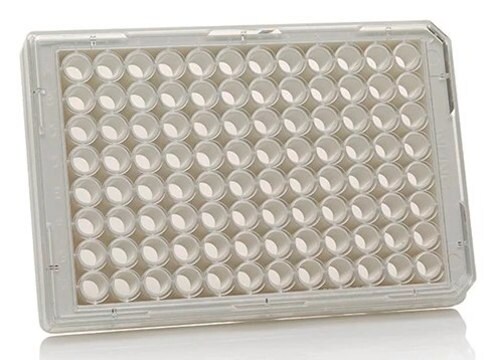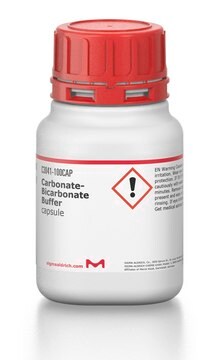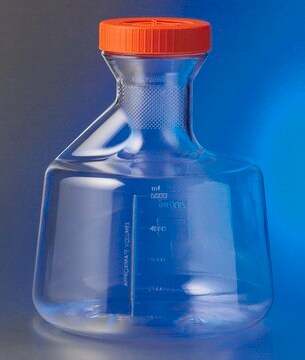S4019
Sodium bicarbonate
Hybri-Max™, powder, suitable for hybridoma, ≥99.5%
Synonym(s):
Sodium hydrogen carbonate
Sign Into View Organizational & Contract Pricing
All Photos(3)
About This Item
Linear Formula:
NaHCO3
CAS Number:
Molecular Weight:
84.01
Beilstein:
4153970
EC Number:
MDL number:
UNSPSC Code:
12161702
PubChem Substance ID:
NACRES:
NA.75
Recommended Products
grade
Hybri-Max™
Assay
≥99.5%
form
powder
technique(s)
cell culture | hybridoma: suitable
impurities
endotoxin, tested
pH
8.3 (0.1 molfreshly prepared)
pKa (25 °C)
(1) 6.37, (2) 10.25 (carbonic acid)
solubility
water: soluble 100 mg/mL
density
2.16 g/mL at 25 °C (lit.)
SMILES string
[Na+].OC([O-])=O
InChI
1S/CH2O3.Na/c2-1(3)4;/h(H2,2,3,4);/q;+1/p-1
InChI key
UIIMBOGNXHQVGW-UHFFFAOYSA-M
Looking for similar products? Visit Product Comparison Guide
Application
Sodium bicarbonate has been used as a supplement:
- in minimum essential medium (MEM)/flushing medium for embryo isolation
- in TCM 199 medium for the collection of cumulus-oocyte complexes (COCs) and in vitro maturation (IVM)
- in IVM medium for in vitro maturation of COCs
Biochem/physiol Actions
Sodium bicarbonate occurs naturally as the mineral nahcolite. It is used to prepare many sodium salts as well as a carbon dioxide source. Sodium bicarbonate is used in the manufacture of fire extinguishers and cleaning agents. Bicarbonate plays an important role in pH regulation in vivo. In biochemistry, molecular biology, and chromatography, sodium bicarbonate is used as a buffer. This Hybri-Max™ product is suitable for use in hybridoma and cell culture research (2.2 mg/ml).
Legal Information
Hybri-Max is a trademark of Sigma-Aldrich Co. LLC
Storage Class Code
13 - Non Combustible Solids
WGK
WGK 1
Flash Point(F)
Not applicable
Flash Point(C)
Not applicable
Personal Protective Equipment
dust mask type N95 (US), Eyeshields, Gloves
Choose from one of the most recent versions:
Already Own This Product?
Find documentation for the products that you have recently purchased in the Document Library.
Customers Also Viewed
Shay P McGuinness et al.
Critical care medicine, 41(7), 1599-1607 (2013-05-21)
Cardiac surgery-associated acute kidney injury occurs in up to 50% of patients and is associated with increased mortality and morbidity. This study aimed to discover if perioperative urinary alkalinization with sodium bicarbonate infusion reduces the prevalence of cardiac surgery-associated acute
Eric A J Hoste et al.
Nephrology, dialysis, transplantation : official publication of the European Dialysis and Transplant Association - European Renal Association, 25(3), 747-758 (2009-08-26)
There have been conflicting reports on the use of intravenous administration of sodium bicarbonate for prevention of contrast-induced acute kidney injury (CI-AKI). The aim of this study was to evaluate the use of sodium bicarbonate for prevention of CI-AKI. This
Sophia Zoungas et al.
Annals of internal medicine, 151(9), 631-638 (2009-11-04)
Intravenous sodium bicarbonate has been proposed to reduce the risk for contrast-induced nephropathy (CIN). To determine the effect of sodium bicarbonate on the risk for CIN. MEDLINE, PubMed, EMBASE, and the Cochrane Central Register of Controlled Trials from 1950 to
Joshua C Tremblay et al.
The Journal of physiology, 593(3), 723-737 (2014-11-25)
Blood flow through intrapulmonary arteriovenous anastomoses (IPAVA) is increased by acute hypoxia during rest by unknown mechanisms. Oral administration of acetazolamide blunts the pulmonary vascular pressure response to acute hypoxia, thus permitting the observation of IPAVA blood flow with minimal
Roberto J Diaz et al.
American journal of physiology. Cell physiology, 306(12), C1191-C1199 (2014-04-25)
We have previously shown that ischemic preconditioning (IPC) protection against necrosis in whole hearts and in both fresh and cultured cardiomyocytes, as well as the improved regulatory volume decrease to hypoosmotic swelling in cardiomyocytes, is abrogated through Cl(-) channel blockade
Our team of scientists has experience in all areas of research including Life Science, Material Science, Chemical Synthesis, Chromatography, Analytical and many others.
Contact Technical Service







